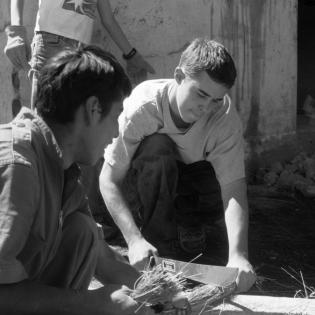Competition vs Collaboration in Philanthropy
Students learn about the power of collaboration, especially in the world of philanthropy. They will discuss: Why would someone want to work with others? What skills and attributes does it require to be a servant leader?
The student will:
- compare and contrast competitive and collaborative behavior.
- analyze the role of collaboration in and between philanthropic organizations.
- Printouts of or access to two online articles -- See Teacher Preparation and Bibliographical Resources
- Student copies of Handout One: Competition/Collaboration Graphic Organizer
Print the following two reading handouts
Article 1: Comar, Natacha. Cisco Blogs. "Competition Inspires Young People to Change the World with Connected Technology," February 18, 2015
Article 2: Entrepreneur. "Competition" http://www.entrepreneur.com/encyclopedia/competition
If desired, create a Google document so that students can build the Competition/Collaboration Graphic Organizer together. Have a projection system available to project the online videos.
- competition: trying to get or win something that someone else is also trying to get or win
- collaboration: working with another person or group in order to achieve or do something
- philanthropy: giving time, talent, or treasure and taking action for the common good
- servant leadership: to be a servant first, then a leader; this puts the highest needs of those being served first
Have students make note of examples of competition and collaboration that they observe in their families and friends.
- Comar, Natacha. Cisco Blogs. "Competition Inspires Young People to Change the World with Connected Technology," February 18, 2015
- Entrepreneur. "Competition" https://www.entrepreneur.com/encyclopedia/competition
- The Johnson Center for Philanthropy. GVSU. "Our State of Generosity" website https://ourstateofgenerosity.org/section/people-working-charitable-sector/
Instructions
Anticipatory Set
Start this lesson with a fun experience comparing the pros and cons of competition and collaboration. The students play an online trivia game twice--one time in competition and a second time with collaboration. There are many trivia games at http://www.sporcle.com/. First, have all the students individually play an online trivia game and each try to earn the highest score in a given amount of time. Record the range of scores and ask students to write a reflection about how they feel about where their score fell and how much they enjoyed playing. Second, group students into small teams who play a trivia game together, helping each other find the answers and trying to earn a high score as a team. Record the range of team scores and ask students to write a reflection about how they feel about where their score fell and how much they enjoyed playing.
Discuss the pros and cons of competition vs collaboration:which is the most fun, which sparks the most participation, which generates the best score, which produces the greater variety of answers, and which is easier?
Have students read the articles about competition and collaboration and then fill out the Competition vs Collaboration Graphic Organizer (Handout 1). Have them save the last two questions for the end of the class period.
From the Our State of Generosity website, project the video clips of Russ Mawby and Jim McHale from Chapter 2: Power of Resources: People Working in the Charitable Sector. http://ourstateofgenerosity.org/section/philanthropy-requires-human-talent/
Discuss how collaboration is especially important in the world of philanthropy.
Finally students should and answer the last two questions on the handout, while looking back at Chapter 2 on the Our State of Generosity website, if needed.
Assess students' understanding by looking for key points on the graphic organizer.
Philanthropy Framework
-
Strand PHIL.I Definitions of Philanthropy
-
Standard DP 01. Define Philanthropy
-
Benchmark HS.1 Define philanthropy to include giving and sharing; volunteering; and private individual action intended for the common good. Explain how a volunteer individual/group can act for the common good.
-
-
Standard DP 03. Names and Types of Organizations within the Civil Society Sector
-
Benchmark HS.1 Recognize and use a variety of terms related to the civil society sector appropriately, and identify the characteristics the terms describe.
-
-
-
Strand PHIL.II Philanthropy and Civil Society
-
Standard PCS 01. Self, citizenship, and society
-
Benchmark HS.4 Describe and give examples of characteristics of someone who helps others.
-
-
